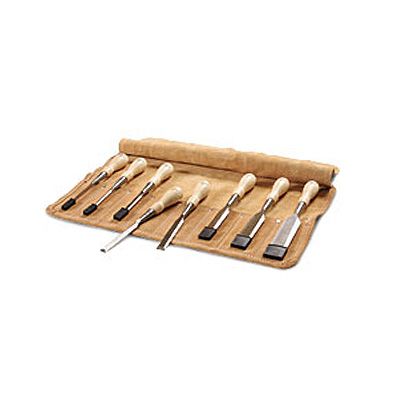Stanley - Stanley- Sweetheart Chisels 750 Series
The Stanley 750s series chisels are machined with 30° factory-ground bevels, and reasonably flat backs.
When Stanley stopped making its 750 series of socket chisels more than 40 years ago, the demand didn’t stop. Revered for their quality and price, these chisels have been widely sought-after on the second-hand tool market for years. Now Stanley has revived the 750 series, offering a great tool with a price that’s within reach.
The 750s are manufactured in Sheffield, England, from high-carbon, chrome steel (the originals were made in the United States). They are precisely machined with clean and consistent beveled edges, 30° factory-ground bevels, and reasonably flat backs.
The chisels required a few minutes of sharpening and flattening before use. Most of the blades in the set had very flat backs, but some needed a bit of extra work to flatten. Overall, I gave the set a B for flatness. One other thing you’ll need to do is lightly hammer the handles into the sockets.
What appeals to me most about the new 750s is their form. They are shorter than other chisels I own. The short length, combined with an easy-to-grip hornbeam handle, gives you nimble, finger tip control over the tool, a plus when you’re chopping and trimming dovetails.
The chisels are light, too, making them perfect for chopping tasks that require holding the blade with one hand while tapping with the mallet. It’s easy to register mallet blows against the handle.
To gauge the edge retention of the blades, I put the chisels through a rigorous performance test on cherry and white oak. Using a mallet, I trimmed the ends of the boards. I also drove the tip of the chisel into the wood repeatedly, simulating the dovetailing process. The edge retention of these chisels is very good.
Despite the high quality, the tools come at a reasonable price. You can buy them individually, but a better value is to purchase sets of eight (1/8 in., 1/4 in., 3/8 in., 1/2 in., 5/8 in., 3/4 in., 1 in., and 11/4 in.) or four (1/4 in., 1/2 in., 3/4 in., and 1 in.). The sets are sold with a nice suede tool roll.
When compared with the other chisels I reviewed in 2008 (FWW #200), the Stanleys rank among the best. They are well made, have great form, and offer great value.
Fine Woodworking Recommended Products

Tite-Mark Marking Gauge

Starrett 12-in. combination square

Veritas Precision Square





















Comments
Chris: I remember well your 2008 review of chisels, resulting in my purchase of several Narex chisels from Highland Woodworking.
When Stanley "re-introduced" their 750 chisels, I purchased the roll of eight from Highland. At first I was set back somewhat with the 30 degree angle. After all, aren't all chisels supposed to be 25 degrees?
None-the-less, the 750's sharpened up nicely with a normal amount of time and effort. For occasional use they were fine.
Now however, this Winter I have embarked on a grueling task of hand dovetailing eight drawers, the fronts with half blind dovetails. All in all, a set of 84 pins and tails. I did so much pounding my neighbor inquired "What are you doing?
During this process of dovetailing in birch and cherry I think I re-sharpened about six times. The edges held up very well and the 30 degree bevel works just fine. With the exception of the 3/8" chisel, I used the 1/8" thru 1" chisels extensively. The 1/8" chisel works great down in the corner recess of the half blind dovetails.
There very well be better chisels available (at much higher cost) but the overall performance of the new 750's will be hard to improve upon.
I have been using a full set of these chisels for a little over a year. I have gotten a lot of use out of them, and generally like them, but have one minor and one major gripe. The minor one - if they are not in a temperature controlled environment the handles drop out. I can't count the times I have reached for a chisel and come away with a handle. Sooner or later I will epoxy them in.
The more serious gripe is the shape of the side of the chisel, which makes it hard to hold in some honing guides. The sloped side of the chisel does not meet the back, instead there is a flat surface that is perpendicular to the back between them. That in itself is not a problem, but the flat surface is narrower at the tip and wider at the handle. When you try to hold that in a Lie-Nielsen honing guide it is only securely gripped at the back of the guide, and the front is free to move (up down and left right) in the guide by a few thou. I eventually worked out a fix by using the flat-sided mortise chisel jaws on the honing guide and putting a wedge in at the back to hold the chisel up against the lip. Until I worked that out I got all sorts of weird angles when sharpening.
Log in or create an account to post a comment.
Sign up Log in